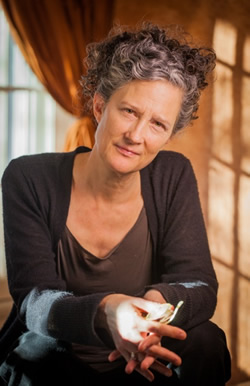|
Sometimes young writers composing their first stories err too heavily in the catastrophe and drama department, too much dark and not enough light. I've noticed that my students like their characters to die in car accidents or of cancer. They also like murder and war, betrayals and lies, psychological and emotional disease, the end of love affairs. They understand that drama is created out of conflict, and happiness therefore seems to them an unpromising subject for fiction. Graphed on a screen like the line that scrolls across a heart monitor, happiness would seem to describe a perfectly straight edge, a monotonous Midwestern horizon of bovine patience and acceptance. Unhappiness, on the other hand, would be represented by a serrated chain of peaks and defiles, a mesmerizing performance of struggle and grief. One story would appear to yield nothing but horizontal sameness, day after day; the other holds out the promise of continual drama.
Yet I am often drawn—as reader and writer—to descriptions of happiness, to moments of joy. I'm drawn, I think, by what seems to me the considerable drama of happiness. Characters who are purely saintly or long-suffering or always sweet will be appalling in fiction, as in life, but the story of the well-lived life, the mystery of people inclined toward charity or kindness, has a drama as compelling as a story of decline and despair. The attraction of happiness for human beings, and the impulse toward goodness or compassion that can meanwhile bear us toward happiness (though there is no guarantee, of course), seems to me as powerful—and as complicated—as the human attraction for evil. In the biblical story of Creation, dark and light are in equal competition for the soul of the world.
It is true that a story needs a conflict in order to be interesting, however. So how does a writer reveal in the flat line of happiness a vital and absorbing human drama? The answer has everything to do with capturing the complexity of happiness, the contradictions it contains—why, after all, do we weep of happiness, for instance?—and with the imperfection of happiness, as well. Happiness is not a sterile, undifferentiated state like the glare of a sunlamp. It is made up of light, but also of shadow. In happiness there are losses and fears; it is those—the experience and the memory of them—that make happiness so sweet. And sometimes, strangely, in our happiest moments we suffer intimations of our mortality, uncanny glimpses of what may lie beyond mortal experience, mysterious vistas that tremble at the horizon.
I am interested in happiness, but perhaps I should say more exactly that I am interested in the difficulty of happiness, or the problem of happiness. It seems to me not a simple thing at all, but something immensely complicated, an exquisitely precarious and ephemeral and nuanced state that depends—in fiction as in life, perhaps—on the nearby presence of unhappiness to be felt most acutely. By necessity, it seems, the happiest man will also be the man most aware of unhappiness.
I spent part of my childhood living on a farm in England. When I look back, those years of my life seem to have gone by blissfully, with no interruption from the world of adults except for occasional meals and baths; in the bathroom with its frigid expanse of white tiles, there was an opaque window of blistered glass, high up, that opened on a crank and through which could be felt on my back and shoulders, while I sat in the warm tub, the cold outside air. I was outdoors onto the farm by first light, inside at dark only regretfully. I was, as they say, perfectly happy. But there were frights aplenty in this paradise: cobwebbed, abandoned cottages in the beautiful beech woods, their thatched roofs sliding dangerously inward; a World War II bomb shelter with its barred door buried in the forest floor; bulls in fields. We were warned about—and yet could not keep away from—the dangerous precipice at the edge of the limestone chalk pits, or the river where one winter I found the body of a deer frozen mid-stream into a grotesque ice sculpture. It had slipped into the water and perished, its neck caught between the forked branches of a fallen tree. Nearly all these details, dark as they are, have made their way into one or another of my books. They and their darkness, their intimation of fear and grief, are a source of deep and abiding happiness to me; they are part of the happiness of that time, and they are necessary to the weight and stature of a description of that happiness, even to the sweetness of it, in my memory. I find I cannot easily separate those things that are light from those that are dark. I do not want to separate them in a story, if the story is to feel true.
I tell my students not to be afraid of light, not to be afraid of happiness, or beauty, or goodness in human beings, or characters who try however imperfectly (or even heroically) to do right in the world. I try to remember, as a writer, that the truth of a story rests in its details, and that everything interesting is made of many parts. To make a night dark, as Chekhov said, you must show a chink of light somewhere. “You'll get a picture of a moonlit night,” he wrote in a letter, “if you write that on the dam of the mill a piece of broken bottle flashed like a bright star.”
Without the light, Chekhov seems to say, there would be no dark.
|


